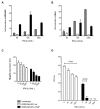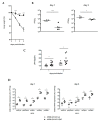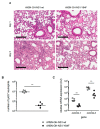A Conserved Residue, Tyrosine (Y) 84, in H5N1 Influenza A Virus NS1 Regulates IFN Signaling Responses to Enhance Viral Infection
- PMID: 28498306
- PMCID: PMC5454420
- DOI: 10.3390/v9050107
A Conserved Residue, Tyrosine (Y) 84, in H5N1 Influenza A Virus NS1 Regulates IFN Signaling Responses to Enhance Viral Infection
Abstract
The non-structural protein, NS1, is a virulence factor encoded by influenza A viruses (IAVs). In this report, we provide evidence that the conserved residue, tyrosine (Y) 84, in a conserved putative SH2-binding domain in A/Duck/Hubei/2004/L-1 [H5N1] NS1 is critical for limiting an interferon (IFN) response to infection. A phenylalanine (F) substitution of this Y84 residue abolishes NS1-mediated downregulation of IFN-inducible STAT phosphorylation, and surface IFNAR1 expression. Recombinant IAV (rIAV) [H1N1] expressing A/Grey Heron/Hong Kong/837/2004 [H5N1] NS1-Y84F (rWSN-GH-NS1-Y84F) replicates to lower titers in human lung epithelial cells and is more susceptible to the antiviral effects of IFN-β treatment compared with rIAV expressing the intact H5N1 NS1 (rWSN-GH-NS1-wt). Cells infected with rWSN-GH-NS1-Y84F express higher levels of IFN stimulated genes (ISGs) associated with an antiviral response compared with cells infected with rWSN-GH-NS1-wt. In mice, intranasal infection with rWSN-GH-NS1-Y84F resulted in a delay in onset of weight loss, reduced lung pathology, lower lung viral titers and higher ISG expression, compared with mice infected with rWSN-GH-NS1-wt. IFN-β treatment of mice infected with rWSN-GH-NS1-Y84F reduced lung viral titers and increased lung ISG expression, but did not alter viral titers and ISG expression in mice infected with rWSN-GH-NS1-wt. Viewed altogether, these data suggest that the virulence associated with this conserved Y84 residue in NS1 is, in part, due to its role in regulating the host IFN response.
Keywords: influenza A viruses; interferon signaling; interferon-stimulated genes; interferon-β; non-structural protein 1.
Conflict of interest statement
The authors declare no conflicts of interest.
Figures











Similar articles
-
Research progress on the nonstructural protein 1 (NS1) of influenza a virus.Virulence. 2024 Dec;15(1):2359470. doi: 10.1080/21505594.2024.2359470. Epub 2024 Jun 25. Virulence. 2024. PMID: 38918890 Free PMC article. Review.
-
Influenza virus non-structural protein 1 (NS1) disrupts interferon signaling.PLoS One. 2010 Nov 10;5(11):e13927. doi: 10.1371/journal.pone.0013927. PLoS One. 2010. PMID: 21085662 Free PMC article.
-
Differences in Type I interferon response in human lung epithelial cells infected by highly pathogenic H5N1 and low pathogenic H11N1 avian influenza viruses.Virus Genes. 2018 Jun;54(3):414-423. doi: 10.1007/s11262-018-1556-1. Epub 2018 Mar 24. Virus Genes. 2018. PMID: 29574656
-
Differential Modulation of Innate Immune Responses in Human Primary Cells by Influenza A Viruses Carrying Human or Avian Nonstructural Protein 1.J Virol. 2019 Dec 12;94(1):e00999-19. doi: 10.1128/JVI.00999-19. Print 2019 Dec 12. J Virol. 2019. PMID: 31597767 Free PMC article.
-
Modulation of Innate Immune Responses by the Influenza A NS1 and PA-X Proteins.Viruses. 2018 Dec 12;10(12):708. doi: 10.3390/v10120708. Viruses. 2018. PMID: 30545063 Free PMC article. Review.
Cited by
-
Gastrodin Inhibits Virus Infection by Promoting the Production of Type I Interferon.Front Pharmacol. 2021 Feb 19;11:608707. doi: 10.3389/fphar.2020.608707. eCollection 2020. Front Pharmacol. 2021. PMID: 33776755 Free PMC article.
-
The applications of live attenuated influenza a virus with modified NS1 gene.Mol Ther Nucleic Acids. 2025 Feb 1;36(1):102471. doi: 10.1016/j.omtn.2025.102471. eCollection 2025 Mar 11. Mol Ther Nucleic Acids. 2025. PMID: 40046952 Free PMC article. Review.
-
Inventory of molecular markers affecting biological characteristics of avian influenza A viruses.Virus Genes. 2019 Dec;55(6):739-768. doi: 10.1007/s11262-019-01700-z. Epub 2019 Aug 19. Virus Genes. 2019. PMID: 31428925 Free PMC article. Review.
-
Research progress on the nonstructural protein 1 (NS1) of influenza a virus.Virulence. 2024 Dec;15(1):2359470. doi: 10.1080/21505594.2024.2359470. Epub 2024 Jun 25. Virulence. 2024. PMID: 38918890 Free PMC article. Review.
-
Back to the future: lessons from past viral infections and the link with Parkinson's disease.Neuronal Signal. 2021 Apr 16;5(1):NS20200051. doi: 10.1042/NS20200051. eCollection 2021 Apr. Neuronal Signal. 2021. PMID: 33953960 Free PMC article.
References
-
- Cumulative Number of Confirmed Human Cases for Avian Influenza A (H5N1) Reported to WHO. [(accessed on 16 March 2017)]; Available online: http://www.who.int/influenza/human_animal_interface/H5N1_cumulative_tabl...
MeSH terms
Substances
LinkOut - more resources
Full Text Sources
Other Literature Sources
Medical
Research Materials

